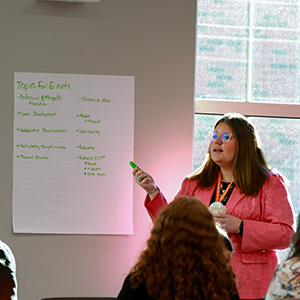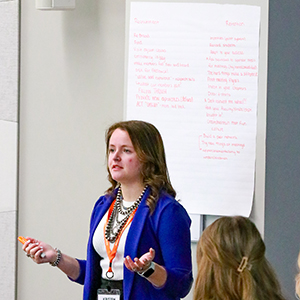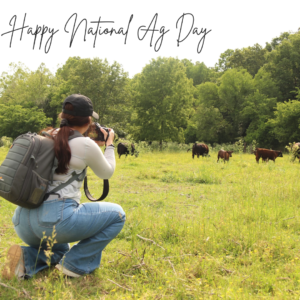National ACT Blog

Stop the Scroll: Tips for Engaging Social Media Content
By: Rylee Coy
“Social media is a powerful tool, but it’s important to stay authentic and consistent. By creating content that is simple, engaging and relatable, your chapter can increase its online presence and inspire more involvement from members and followers alike.”
Social media is a crowded space — catching your audience’s attention isn’t always easy. For organizations like National ACT and local ACT chapters, creating eye-catching and meaningful content is essential for building a strong online presence. Here are some strategies to help your chapter stand out and “stop the scroll.”
One of the best ways to increase engagement is to focus on content that’s simple, yet effective. Start with these tips to keep your make sure your content is effective, yet engaging:
Reels drive engagement. Short videos like Instagram Reels are perfect for showcasing events or providing quick updates in a fun, dynamic way.
Less is more. Keep text on your graphics to a minimum. A clean, concise design with impactful visuals will grab attention faster.
Feature people, not just graphics. Balance your feed with photos of members and events to make it feel personal and engaging.
Tag other organizations. Collaborate with other groups? Tag them to increase reach and visibility.
Need inspiration on what to post on your chapter’s social media to make sure information is getting to your audience and engaging them? Here are some ideas for creating compelling content:
Announce your meetings. Regularly post meeting reminders. Consider using a consistent theme for these posts so members can recognize them instantly.
Show what your chapter is up to. Share highlights of your organization’s activities to inspire involvement and curiosity.
Senior Spotlights. Shine a light on your senior members. It’s a great way to celebrate their achievements while fostering a sense of community.
Meeting recaps. Share quick highlights of your chapter’s recent meetings. This keeps everyone in the loop and reminds members of what they missed.
Fundraiser promotions. Social media is the perfect place to promote fundraising efforts. Make your posts clear, compelling and shareable.
Internship and job opportunities. Your members will appreciate posts that highlight ways to advance their careers.
Day in the life. Give followers a behind-the-scenes look on meeting days to humanize your chapter and build connections.
Social media is a powerful tool, but it’s important to stay authentic and consistent. By creating content that is simple, engaging and relatable, your chapter can increase its online presence and inspire more involvement from members and followers alike.

Fundrasing Ideas for Chapters
By: Kendal Brown
“However, fundraising is more than just raising money—it’s an excellent way to encourage member involvement, foster teamwork and bring members together for a shared goal.”
Fundraising is essential to providing financial stability to a university’s Agricultural Communicators of Tomorrow (ACT) chapter. With proper funds, ACT organizations can offer more opportunities for their members, such as guest speakers, adequate meeting facilities, new technologies and/or meals for meetings
However, developing a successful fundraising plan can be challenging, especially when competing with other campus organizations for financial support.
During National ACT’s January Think Tank, members discussed creative ways their chapters have raised money to support their activities. Here are some of the ideas shared:
Photography Contest & Calendar Sales
Photography Contest
ACT chapter members create 12 photo categories, each representing a month in the calendar (e.g., livestock, landscapes, industry-related scenes).
Members collect and organize photo entries for each category.
Once the submission deadline passes, judging begins.
A winning photo is selected for each category, and that image is featured in the corresponding month of the calendar.
Calendar Production & Sales
After the winning photos are chosen, the calendar is designed and finalized.
The chapter orders printed copies and launches sales within their university, local community, and beyond.
This fundraiser not only generates revenue but also provides members with hands-on experience in agricultural communications, from photography and design to marketing and sales.
Headshot Night
A Headshot Night is a simple but effective fundraiser for chapters that have access to a camera. The idea is to invite ACT chapter members to a monthly meeting and offer professional headshots at a low cost.
One chapter shared a successful approach:
Members received a free headshot, encouraging attendance and participation.
Non-members (friends or fellow students) paid a small fee ($5 or $10) for their headshot.
The more guests members invited, the more funds the chapter raised.
This fundraiser not only helps students update their professional images but also strengthens chapter involvement by encouraging members to bring others into the ACT community.
Button/Pin and Sticker Sales
Designing and selling buttons, pins, or stickers is a great way to generate revenue, showcase the chapter’s graphic design skills, and boost visibility within the university.
How to Organize This Fundraiser
Design Creation
Assign a few members to create designs.
Consider your target audience (e.g., agriculture majors, ACT branding, or common ag phrases).
Production
Get designs printed on buttons/pins or stickers.
If selling buttons, use a button maker to assemble them.
Sales and Promotion
Plan dates, times, and locations for the fundraiser.
Share design previews to generate interest.
This fundraiser is easy to implement with active member participation and can bring in consistent revenue for the chapter.
Final Thoughts
By incorporating these fundraising ideas, your chapter can generate extra income to support meetings, activities, and new opportunities. However, fundraising is more than just raising money—it’s an excellent way to encourage member involvement, foster teamwork and bring members together for a shared goal.
With the right strategy, your ACT chapter can increase financial stability while strengthening the organization and its members in the process.

Behind the Scenes: What It Takes to Plan a Successful EventBy: Jenna Fiscus
“By prioritizing thoughtful planning, clear communication, and focusing on attendees’ needs, students can create successful and memorable events that stand out.”
To the untrained eye, events seem to come together with just one or two main coordinators. However, as students shared at the recent National ACT Professional Development Conference (PDC), there is so much more happening behind the scenes!
The Foundation of Event Planning
Successful event planning starts with key elements in place:
Establishing a team early – A strong, dedicated team is essential.
Setting clear objectives – What do you want attendees to gain from the event?
Developing organization tactics – Finding a system that works for the team ensures efficiency.
Creating a timeline – A well-structured schedule keeps everything on track.
Beyond these basics, students at PDC explored and shared creative event ideas to enhance experiences at their own universities.
Think Tank Discussions at PDC
At the January Think Tank, held in person at PDC, students discussed the issues they hoped to address by hosting events. Some key topics included:
Career Preparation – Resume-building workshops and professional readiness.
Technical Skills – Adapting to trending technology like podcasting.
Entrepreneurial Advice – Financial strategies for starting a business.
Personal Branding – Helping students develop a strong professional identity.
Top Event Planning Tips
Among the most popular tips shared by students were:
Be personable – Engage with guests and professional speakers.
Find your organizational style – Stick with the system that works best for your team.
Stay communicative – Keep the team updated and informed.
Prioritize attendee experience – Offer relevant speakers and breakout sessions tailored to interests.
The Importance of Adaptability
No matter how well-planned an event is, challenges are inevitable. Students emphasized that successful event planners must be able to:
Adapt quickly to last-minute changes.
Handle technical difficulties with ease.
Maintain composure under pressure.
Flexibility and quick decision-making can make all the difference in ensuring a seamless experience for attendees.
Creating a Lasting Impact
The biggest takeaway from the conference? Great events go beyond organization—they create lasting impact.
Offer meaningful networking opportunities.
Provide hands-on workshops and engaging keynote speakers.
Ensure every event brings value to its participants.
By prioritizing thoughtful planning, clear communication, and focusing on attendees’ needs, students can create successful and memorable events that stand out.

Networks Unlock Opportunities
By: Andrew Angulo
“Networking is not about just connecting people. It’s about connecting people with people, people with ideas and people with opportunities.” – Michelle Jennae
In January, our team had the privilege of attending The National ACT Professional Development Conference hosted by Oklahoma State University ACT. When I entered the weekend on unfamiliar territory, I made it my mission to accept every idea with an open mind. After a great weekend, I considered the importance of opportunities like PDC to the development of young professionals during my return to California.
My biggest takeaway from the weekend I spent with over 80 ag communicators from across the country are the ideas I gained. I feel the quote presented above really embodies my time in Oklahoma; the connections I make open doors for opportunity. I would urge anyone to step out of their comfort zones, attend events centered around professional development and gain ideas to unlock future opportunities.
There is no “perfect” or “absolute” way to network: it is important to understand your strengths and utilize them to maximize the output from a networking opportunity. Here are three areas that I stress to get yourself on the right track when networking:
Actively Participate: Don’t just sit back and observe! Actively participate in the conference by asking questions, joining workshops and engaging in discussions. This not only boosts your own learning but also helps you stand out and connect with others. Show your passion and commitment by being an active participant.
Note and Follow up: Take thorough notes during sessions to solidify your learning and have a valuable resource to reference later. I strongly encourage speaking to a presenter after their session, connect with them on LinkedIn or ask for a business card! Open the door to a professional relationship by establishing interest in one! Send personalized follow-up emails or send a message on LinkedIn, sharing what you learned from them and express interest in building a connection. A simple follow-up can transform a brief meeting into your next career opportunity.
Network Strategically: Research, Research, Research! Before attending a conference, research who will be attending and the speakers to maximize your networking potential — you never want to go in blind. Identify individuals or companies you’d like to connect with and actively seek them out. Attend networking events, participate in discussions and don’t hesitate to approach speakers after their sessions.
Remember, it’s not always what you know, it’s who you know!

Beyond the Numbers: Making an ACT Chapter People Want to Join
By: Kristen Smith
“I’m a passionate person, a lot of us are – especially a lot of people with the passion for agriculture communications and advocating for agriculture. But not EVERYONE is as passionate about ACT as we are.”
Let’s get right into the nitty gritty of things – recruitment and retention. Two challenging things.
I’m a passionate person, a lot of us are – especially a lot of people with the passion for agriculture communications and advocating for agriculture. But not EVERYONE is as passionate about ACT as we are. I know, it breaks my heart too. But I am here to tell you that it is okay.
Everyone has their place in this organization and don’t be so hard on yourself because the same ten people have come to the past three ACT meetings. For the longest time, I was guilty of this – asking myself all of the wrong questions on why we weren’t recruiting as many members, or we weren’t retaining the ones we had worked so hard to recruit. It took me a long time to stop for a second, take a step back and start asking myself “how can we make this the best experience for everyone involved,” instead of “why aren’t we seeing the numbers in xyz.”
It took me all too long to get past this, but at the 2025 National ACT PDC Conference in Stillwater, Oklahoma, I was so overjoyed with the conversation that my first ever Think Tank group had on their own recruitment and retention processes. Some of my biggest takeaways are below:
Re-brand! When was the last time your chapter had a rebrand? Maybe you need some refreshed apparel, buttons or stickers! A little refresh can go a long way – it may just be a perk to recruit someone new!
FOOD! Work hard to make sure your budget allows for some sort of food at your meetings. You can even reach out to agricultural companies in the community to sponsor/cater and be a quick guest-speaker! Students also LOVE and miss home-cooked meals, so ball on a budget and have a home-cooked meal!
Invest in your chapters. If a student pays dues, throw in a shirt with that – then you’re promoting your club.
Consistency is key. This is a bigger deal than many think, but if you create a stable and consistent schedule – it can help retain those members.
These last few are HUGE (write them down!)
Ask for feedback. You don’t want to constantly talk at your ACT chapter, you want to talk to them. Make your members feel both seen and heard. That in itself will make them feel valued and encourage them to keep coming back.
Value added experience. I heard this talked about often at PDC, especially amongst the Oklahoma State University students (shoutout to y’all)! What can members gain? What are they currently gaining and what can be ADDED to make their experience more worth-while?
Follow through. Provide those new experiences to members and deliver on your promises.
Have your faculty, staff and department bought in. If your professors are bought in to you guys, they can advocate for you as a club to other students, staff and industry professionals. They want to see you succeed, so let them support you.

Prepare, Engage, Thrive: Making the Most of Professional Development Opportunities
By: Jenna Fiscus
“In an ever-evolving industry, the goal remains the same: to feed, sustain and promote a healthier, greener world. This mission is not taken lightly. and in an industry so essential to society, it’s crutial that those who feed the world also invest in their own growth.”
“Growth is never by mere chance; it is the result of forces working together,” James Cash Penney reminds us. In both the National Agricultural Communicators of Tomorrow’s newly revised mission and vision statements, key components include professional development and networking with our peers. It is in places such as these where we can share ideas and learn from one another. As we prepare for our annual Professional Development Conference, we remember that the most successful events are those planned with intention.
Here are some tips to maximize your experience:
Know your vendors and speakers. Before the event, review the schedule and list of participants. Identify the booths, breakouts, and professionals you want to engage with. Don’t leave the event wishing you had more time — take the time to plan.
Scope out your surroundings. Plan your logistics: when will you eat? How long does it take to get from your hotel to the first session? Will you need coffee before heading in? By familiarizing yourself with these details, you’ll set yourself up for success.
Prepare your bag. Bring a professional bag to organize your business cards, notebook, pens, resumes, and other essentials. The more organized you are at the start, the easier it will be to maintain that organization throughout the day. Always bring a notetaking device — digital or physical — and extra pens or a portable charger if you’re using digital tools.
Have printed materials ready. If you plan to share business cards, resumes, or a portfolio, prepare them in advance. Ensure all information is accurate and have enough copies ready to distribute. Keep them easily accessible in a separate compartment of your bag so you can find them quickly when needed.
Plan your follow-up strategy. After a long day, it’s easy to feel drained, but following up with new contacts is essential. Be proactive by preparing an email template where you can fill in the details of your conversations later that evening or the next day. This ensures timely follow-up and strengthens your new connections.
Professional development is an exciting opportunity, and when approached strategically, it can lead to valuable conversations and new insights. However, the experience is often defined by the preparation leading up to the event. Don’t let this crucial step pass you by — embrace the opportunity to step into the agricultural industry and be shaped and inspired by others in your field. We’ll see you in Stilly!

Visual Storytelling Through Graphic Design and Photography: Engaging Agricultural Communication
By: Sophia Sedillo
“Visual storytelling through graphic design and photography is key to effective agricultural communication. National ACT can inform, inspire, and engage audiences, fostering a greater understanding and appreciation of agriculture. A well-crafted image can create connections that words alone might not achieve.”
Visual storytelling through graphic design and photography is crucial in agricultural communication. It captures attention, conveys complex messages clearly, and connects farmers to consumers. For National ACT, these tools are essential for engaging diverse audiences effectively.
Images tell stories. In agriculture, they highlight sustainability, innovation, and the human touch behind food production. According to the Content Marketing Institute, articles with relevant images get 94% more views. High-quality graphics and photos make agricultural narratives relatable and memorable.
Graphic design uses colors, fonts, and layouts to create appealing content. Infographics simplify complex data, making topics like soil health or pest management accessible. Consistent design elements build a recognizable and trustworthy brand image, vital for the National ACT’s messaging.
Photography captures the essence of agriculture, showcasing hard work and innovation. Authentic, high-resolution images resonate with viewers, fostering a deeper connection and appreciation for agriculture. Photos highlighting the vibrancy of agriculture and the dedication of farmers and ranchers can inspire as well as inform.
Combining striking visuals with informative graphics creates engaging narratives. For example, a post on sustainable farming can be enhanced with photos and infographics illustrating benefits. Tools like Adobe Photoshop and Canva make it easy to create and edit professional-grade visuals.
Our 5 Tips for Visual Storytelling.
1. Know Your Audience: Tailor visuals to resonate with farmers, policymakers, or consumers.
2. Keep It Simple: Use clear, straightforward visuals.
3. Be Authentic: Use real images to build trust.
4. Consistent Branding: Maintain a consistent style across all visuals.
5. Optimize for Platforms: Fit visuals to different platforms, from social media to print.
Visual storytelling through graphic design and photography is key to effective agricultural communication. National ACT can inform, inspire, and engage audiences, fostering a greater understanding and appreciation of agriculture. A well-crafted image can create connections that words alone might not achieve.

The Fear to Embrace & Overcome with Time
by: Kensie Darst-Todd
by: Kensie Darst-Todd
“Today, I see public speaking as an opportunity rather than a fear. It’s a chance to share my ideas, inspire others, and grow personally and professionally. If I can transform from a nervous speaker to a confident one, so can you. Embrace the journey, practice relentlessly, and remember that every step forward is a victory. Your voice matters—let it be heard with confidence.”
Public speaking is an insurmountable hurdle, and it is the number one fear facing Americans today. I used to fear speaking in front of audiences, large and small, my hands trembling and my voice quivering. Over time, I learned that confidence in public speaking is not an innate gift but a skill that can be developed with practice and perseverance.
My journey began with small steps. When I joined the National FFA Organization as a freshman in high school, I met people from all across the nation coming from all walks of life, each with their own fears and goals. Through the organization, I developed impactful relationships and had meaningful conversations. This supportive environment allowed me to make and learn from mistakes without judgment. It was here that I realized the importance of preparation. Knowing my material inside out gave me a sense of control and reduced my anxiety.
Another key lesson was the power of visualization. Before any speech, I would close my eyes and imagine myself speaking confidently, engaging with the audience, and delivering my message effectively. This mental rehearsal helped build my self-assurance. I would rather see myself leaving the room feeling confident in my ability to speak rather than walking away, fearful of what others may think of me from that moment forward.
I also learned to embrace my unique voice. Instead of trying to mimic great orators, I focused on being authentic. Sharing personal stories and speaking from the heart made my presentations more relatable and impactful. The audience connects with genuine emotion, and that connection boosts confidence.
Today, I see public speaking as an opportunity rather than a fear. It’s a chance to share my ideas, inspire others, and grow personally and professionally. If I can transform from a nervous speaker to a confident one, so can you. Embrace the journey, practice relentlessly, and remember that every step forward is a victory. Your voice matters—let it be heard with confidence.

The Benefits of AMS
by: Kyndal King
“Last year I attended this conference with my classmates, and needless to say it changed the direction of my life. It gave me a fresh perspective on agriculture, showed me jobs in agricultural communications and media that I didn’t know existed, introduced me to life-long friends and connections, and ended with the ACT membership electing me as a National ACT officer. This trip had my creative juices flowing and helped me start seeing my career dreams as reality.”
I don’t know about you, but when I was in college I was constantly searching for professional development opportunities and a chance to speak with people working in agriculture. There is only so much one can learn from keeping their nose in textbooks and countless Google searches using the perfect combination of keywords. I am eager to hear from people within our industry with first-hand experience so I can soak up as much information as possible. If you’re sitting there thinking to yourself “same,” then do we have the perfect summer trip for you!
Join our National ACT team, and hundreds of industry leaders, at the 2024 Agricultural Media Summit in Kansas City, Missouri, August 4-6! This year, AMS will feature guest speakers from across the industry, allow for members to network with each other and industry professionals, and provide a greater insight into the agricultural communications industry as a whole. Plus, we’ll be attending the Kansas City Royals baseball game one evening as a National ACT organization!
Last year I attended this conference with my classmates, and needless to say it changed the direction of my life. It gave me a fresh perspective on agriculture, showed me jobs in agricultural communications and media that I didn’t know existed, introduced me to life-long friends and connections, and ended with the ACT membership electing me as a National ACT officer. This trip had my creative juices flowing and helped me start seeing my career dreams as reality.
To learn more about the Ag Media Summit and the opportunities available at the conference, visit www.agmediasummit.com.
Our team wants to answer any questions you might have about AMS or becoming a national ACT officer — elections take place at our business meeting during the conference! Please feel free to message us on any of our socials with any questions you might have or reach out to us with the contact info on our website, nactnow.org.
Bring your barbecue appetite, baseball glove and note taking device — it’s time to travel! We can’t wait to see everyone in Kansas City!

Networking Tips
by: Sophia Sedillo
“By implementing these networking strategies, you can build valuable professional relationships and create opportunities for personal and career growth. Remember, networking is about building genuine connections and offering value to others as much as receiving it.”
In today’s professional world, networking is essential for career development and success. Whether you are just starting out or looking to advance in your field, effective networking strategies can open up doors to new opportunities and connections. Here are some key strategies to consider:
Leverage online platforms: Social media platforms like LinkedIn offer excellent opportunities for networking. Create a professional profile, engage with others’ content, and share your insights. Join industry-specific groups to stay informed and connect with like-minded professionals.
Attend events and conferences: Industry events provide a space to meet professionals in your field. Attend conferences, workshops, and seminars to expand your network. Prepare conversation starters and bring business cards to leave a lasting impression. Try it out at Ag Media Summit in August!
Follow up: After meeting someone new, follow up with a personalized message. This could be a LinkedIn connection request, an email, or even a handwritten note. Express gratitude for their time and mention key points from your conversation.
Join professional organizations: Become a member of professional organizations related to your industry; like National Agricultural Communicators of Tomorrow. This provides access to networking events, educational resources, and potential mentors.
Cultivate relationships: Networking is a long-term endeavor. Nurture your connections over time through regular communication and engagement. Share updates about your career, congratulate others on their achievements, and offer support when needed.
Practice active listening: When networking, listen actively to others. Ask open-ended questions and show genuine interest in their experiences and insights. This fosters meaningful conversations and helps you learn more about your connections.
Stay positive and open-minded: Approach networking with a positive attitude and an open mind. You never know where a conversation might lead, so be open to unexpected opportunities and connections.
By implementing these networking strategies, you can build valuable professional relationships and create opportunities for personal and career growth. Remember, networking is about building genuine connections and offering value to others as much as receiving it.

Crafting Your Online Presence
by: Kensie Darst-Todd
“Big ideas always have small beginnings, so consider where you want to see your social platform down the road. Who would have guessed in 1741 how large of a market magazines would be or how radio broadcasting would influence the world today? It just takes one small step to make a significant impact.”
Social media is a token of a milestone for how far we have come in communications. We have sought many ways to tell stories through platforms throughout the years, from publications like Andrew Bradford’s American Magazine in 1741 to 1920 when the first radio broadcast aired. Since then, the development of our communications has expanded beyond the imagination of the days when storytelling through different mediums had just begun.
When we think about today’s social media usage, we may think of the influencers used to market products in collaboration with a company or the many memes posted after a hysterical incident on live television. Perhaps we think of social media as a platform to receive news about recent events that shocked the world. Whatever you may think of is valid because we all share different experiences and use social media in various ways.
As communicators, we often find times when we learn about a heartfelt or potentially award-winning story we want to share with our followers but will not be read by as many as intended. We may feel we need a significant presence on social media to share compelling and impactful messages.
Here are three tips to build a more prominent presence for your social media platform:
Determine the purpose of your platform. Different platforms serve different purposes. For example, Instagram is used for compelling images or videos that capture a moment in time to share with others. In contrast, LinkedIn is used to network with clients, employers, and audiences with similar interests. Determining which platform you will primarily use will influence the content you choose to share.
Find your voice and style with authenticity. Your followers are inclined to follow your content on social media because they find inspiration, similarities, or valuable information on your page. Identify your voice to be consistent in the tone of your messages, and always be authentic with yourself and your followers! Sticking to your authentic brand will build trust between you and your audience.
Be consistent! Have you ever heard the term, consistency builds credibility? That applies here, too! Maintaining consistent content posting will not only make you more of an influential storyteller, but it will also increase your followers! Followers enjoy looking for creators they can escape to and be part of their daily lives. Posting on your feeds and stories helps achieve a high number of followers per account. Creating a content calendar and a list of ideas to post will assist you in your creative journey!
Seek advice from mentors. As mentioned, social media can be used to network with other users. Creators use different strategies to increase their audiences and take alternative creativity routes to reach larger platforms. Don’t be afraid to reach out to other users to ask questions and learn from them!
Never be afraid to take a leap of faith and believe in something you want to begin! At first, it can be challenging to build in time to maintain consistent posting or to find the voice you want to stick with, but it will be worth it after some time. Big ideas always have small beginnings, so consider where you want to see your social platform down the road. Who would have guessed in 1741 how large of a market magazines would be or how radio broadcasting would influence the world today? It just takes one small step to make a significant impact.

National Ag Day:
Contributing as Communicators
by: Alison Chaney
“While bit necessarily laboring in the field-day-to-day – shout out to those of you who are – agricultural communicators are equally important to the agricultural industry, While we are not doing the work directly, we are often behind the scenes with out cameras, computers and pens. We are responsible for telling workers’ stories. We bridge the gap between producers and consumers. But, how can we tell these stories?”
National Agriculture Day is a day for celebrating farmers, farm workers, ranchers, fisherpeople, foresters, and other agricultural workers. As communicators in agriculture, how do we fit in and positively contribute to the industry?
While not necessarily laboring in the field day-to-day – shout out to those of you who are – agricultural communicators are equally important to the agricultural industry. While we are not doing the work directly, we are often behind the scenes with our cameras, computers and pens. We are responsible for telling workers’ stories. We bridge the gap between producers and consumers. But, how can we tell these stories?
We’re sharing our top 5 tips for finding your place in agricultural communications space:
Find Your Niche
College is a time for you to find what you love. Try everything! If you are not a writer, try picking up a camera. Try graphic design or social media if a camera is too intimating. Or, maybe you’ve got the natural gift of gab! Become a public speaker or PR rep. There truly is something for everyone in communications.
Expand Your Network
Take advantage of conferences and other agricultural events. These conferences and events are where you can be shoulder-to-shoulder with industry professionals. In our small world, it is almost guaranteed you will probably work with someone you have previously met at one of these professional events. P.S. Registration for Ag Media Summit this summer is now open.
Increase Your Knowledge
Staying up to date on and savvy with relevant information and technology is a great way to stay current with the stories we tell. While reading may not be your idea of fun, it is a way to increase your understanding of a new topic or idea.
Take an Internship or Job Shadow
Internships and job shadows are another way to get industry experience, expand your network and increase your knowledge. They allow you to try different things and get more comfortable with working. Even though you can try really hard, the value you’ll learn in the trenches can’t be learned from a book or in a classroom.
Converse With PeopleHave a conversation with people about their experiences and discover what you can do to help spread their story. At the core of it, all agricultural communicators or more than the job they do. Have authentic conversations with folks. Learn about them! You never know how a conversation about your recent travels and experiences could be the starting point of a great connection with a future boss.
Finding your place in the agricultural industry is all about pushing yourself out of your comfort zone. While we may not be right in the nitty gritty with dirt under our nails, we have the unique ability to capture the details and portray a lifestyle and story. So, put on your boots, grab your fully loaded backpack and explore what our industry offers! It is time to ACTivate Your Agriculture!